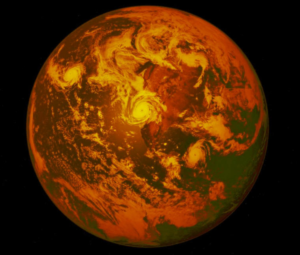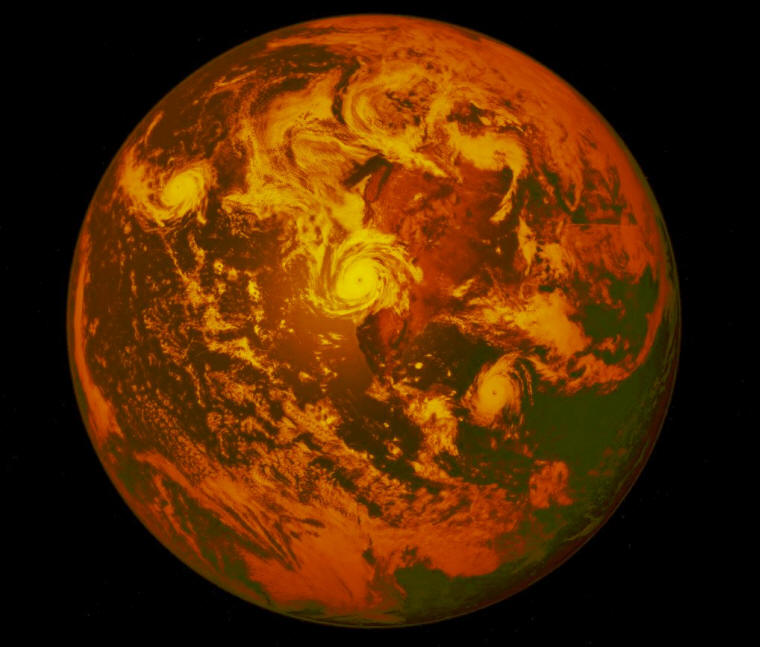From doomsday blockbusters like Armageddon to The Day After Tomorrow, Hollywood has often imagined catastrophic scenarios depicting the end of our world. While these films captivate audiences with dramatic and exaggerated narratives, a recent scientific study has unveiled a truly chilling glimpse into a potential future for our planet that surpasses even Hollywood’s wildest imaginations.
Led by astronomers at the University of Geneva (UNIGE) in collaboration with France’s CNRS laboratories in Paris and Bordeaux, researchers have simulated what’s known as a ‘runaway greenhouse effect.’ This simulation paints a grim picture of Earth’s fate, portraying a scenario where our planet could transform into an ‘uninhabitable hell’ resembling Venus, our celestial neighbor.
What’s particularly alarming about this study is that the timeline for such a catastrophic transformation may be much closer than anticipated. Scientists warn that a runaway greenhouse effect on Earth could occur within a couple of hundred years, or even sooner, plunging our planet into an environmental catastrophe of unprecedented proportions.

The concept of a runaway greenhouse effect involves a rapid and accelerating increase in global temperatures caused by a hot and water-vapor-rich atmosphere that inhibits the emission of thermal radiation into space. This atmospheric configuration prevents Earth from cooling down and maintaining liquid water on its surface, leading to a vicious cycle of escalating global warming.
Venus, often regarded as Earth’s malevolent twin, serves as a haunting example of the potential consequences of a runaway greenhouse effect. Despite similarities in size and composition with Earth, Venus boasts an average surface temperature of a scorching 870°F (465°C), making it the hottest planet in our solar system. Its dense atmosphere traps heat, creating a hostile environment with temperatures high enough to melt lead and an atmosphere filled with toxic clouds of sulfuric acid.
The research conducted by the UNIGE team emphasizes the critical role of water vapor in triggering a runaway greenhouse effect on Earth. While carbon dioxide and methane are known contributors to global warming, water vapor may be the ultimate catalyst. As our planet warms due to increased greenhouse gas emissions, more water vapor enters the atmosphere through ocean evaporation, exacerbating the greenhouse effect.
This feedback loop of escalating temperatures and rising water vapor levels eventually reaches a critical threshold, beyond which Earth cannot cool down. Oceans evaporate entirely, and temperatures soar to unimaginable levels, rendering our planet uninhabitable.
Using advanced climate models, scientists demonstrated that even a slight increase in solar radiation could push Earth past this critical threshold, triggering an irreversible chain reaction. In this grim scenario, Earth could become as inhospitable as Venus, with conditions too extreme to support life.
Understanding this phenomenon is crucial not only for Earth but also for studying exoplanets with oceans. By analyzing the temperatures of exoplanets, scientists can assess their potential to harbor life beyond our solar system.
The findings of this study, published in Astronomy & Astrophysics, serve as a sobering reminder of the urgent need to address climate change and reduce greenhouse gas emissions. The consequences of a runaway greenhouse effect are dire, and the time to act is now.
Humanity must take immediate and substantial steps to transition to sustainable energy sources, reduce greenhouse gas emissions, and prioritize the preservation of our planet’s climate. The fate of Earth hangs in the balance, and the choice is clear: act now or face a future that even Hollywood’s most dystopian films could not adequately portray.

